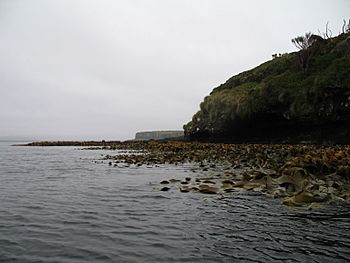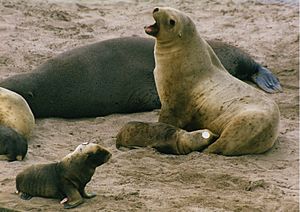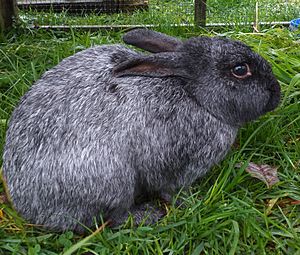Enderby Island facts for kids

A view along the coast of Enderby Island
|
|

Topographical map of the Auckland Islands
|
|
Quick facts for kids Geography |
|
|---|---|
| Coordinates | 50°29′45″S 166°17′44″E / 50.49583°S 166.29556°E |
| Archipelago | Auckland Islands |
| Administration | |
|
New Zealand
|
|
Enderby Island is a special island that is part of New Zealand's Auckland Islands group. These islands are not lived on by people. Enderby Island is located south of mainland New Zealand. It sits just off the northern tip of Auckland Island, which is the biggest island in the group.
Contents
Island Geography and Formation
Enderby Island is found near the northeast end of Auckland Island. It is about 3 kilometers (1.9 miles) away from the mouth of Port Ross. Several smaller islands are in the water between Enderby and Auckland Island. These include Rose, Ewing, and Ocean Island. Rose Island is between the two main islands, separated by two narrow channels, each about 400 meters (437 yards) wide. Enderby Island makes up about 1% of all the land in the Auckland Islands.
Enderby Island has some interesting features. It has cliffs and rocky shores all around. The only place to land a boat is at Sandy Bay, on the island's southwest side. You can find old huts there. This bay is also home to a group of New Zealand sea lions. Much of the island's middle part is wet and marshy, with many small streams. A small lake, called Teal Lake, is near the southeast shore. The very northernmost point of the island is Derry Castle Reef. It is named after a ship called Derry Castle, which crashed there in 1887.
Enderby Island sits on the Campbell Plateau, which is like an underwater shelf. The island is made of old volcanic rocks. These rocks were formed from volcanoes that erupted between 25 and 10 million years ago.
Island History and Shipwrecks

Long ago, Polynesian explorers came to Enderby Island. This was in the 13th or 14th centuries, around the same time people settled in mainland New Zealand. Scientists found signs of their visit at Sandy Bay. This spot was good because it was sheltered and had access to seal colonies. They found old cooking pits with bones from seals, sea lions, fish, mussels, and birds like albatrosses. The Polynesians stayed for one or more summers. They left behind tools like scrapers and fish hooks.
After the Polynesians left, the Auckland Islands were empty for a long time. Then, in 1806, Abraham Bristow rediscovered them. He was on a whaling ship called Ocean. He named the island after the ship's owners, Samuel Enderby & Sons.
The Derry Castle Shipwreck
On March 20, 1887, a ship named Derry Castle crashed near Enderby Island. It was an iron barque, a type of sailing ship, from Boston, USA. The ship was on its way from Australia to England. It had 23 sailors and one passenger. The Derry Castle was carrying wheat.
The sailors who survived the shipwreck found a castaway depot at Sandy Bay. These depots were huts with supplies left by the New Zealand government for shipwrecked people. The survivors built more simple shelters around the depot. They buried their dead shipmates on a cliff overlooking the water. They marked the grave with the ship's figurehead, which is a carved figure from the front of the ship.
After 192 days, the Derry Castle was officially listed as missing. But then, on September 21, 1887, a small steamer called the Awarua arrived in Australia. On board were the eight survivors from the Derry Castle. The Awarua had been on an illegal sealing trip in the Auckland Islands.
The grave site of the Derry Castle sailors was looked after by the New Zealand government for many years. During World War II, the ship's figurehead was put back up by coastwatchers. These were people stationed on the islands to watch for enemy ships. Today, you can see the figurehead and other items from the wreck at the Canterbury Museum in Christchurch, New Zealand. A tombstone now marks the grave site on the island.
Island Animals and Plants

In 1994, people worked to remove animals that were not native to Enderby Island. These included cattle, pigs, rabbits, and rats. By 2015, there were many more native animals compared to Auckland Island. Enderby Island is part of the Auckland Island group Important Bird Area (IBA). This means it is a very important place for birds. Many seabirds breed here. It is also home to special birds found only in the Auckland Islands. These include the Auckland shag, Auckland teal, and Auckland snipe.
Other animals you might find include the brown skua, New Zealand pipit, New Zealand sea lion, northern giant petrel, and yellow-eyed penguin. The main plants are rata forest and large plants called megaherbs. One example is the Campbell Island carrot.
Old bird bones found in sand dunes on Enderby Island show that many seabirds still live there today. However, the number of some species has changed over time.
Enderby Island Cattle
Like rabbits, cattle were brought to Enderby Island in the late 1800s. Shorthorn cattle were brought by whalers in 1894. They survived by eating kelp and other plants on the island. This made them a unique wild type of cattle. By the mid-1980s, these cattle had eaten almost all the plants on Enderby Island. The New Zealand's Department of Conservation decided to remove the cattle from the island. By the mid-1990s, only one cow, named 'Lady', was left. Lady was taken to mainland New Zealand in February 1993. Since then, people have worked hard to save this special type of cattle. This even included cloning. Lady died in May 2009 when she was over twenty years old.
Enderby Island Rabbits
A special type of rabbit used to live on Enderby Island. Rabbits are not native to the island. Their ancestors were brought from Australia in October 1865. They were meant to be food for people who might get shipwrecked. After they were brought to the island, the rabbits lived there by themselves for almost 130 years. The rabbits were removed from the island in the early 1990s. However, some were saved, and the breed still exists in special places. Enderby Island rabbits are mostly silver-grey. But a small number of them are cream or beige because of a special gene.
See also
 In Spanish: Isla Enderby (Nueva Zelanda) para niños
In Spanish: Isla Enderby (Nueva Zelanda) para niños



